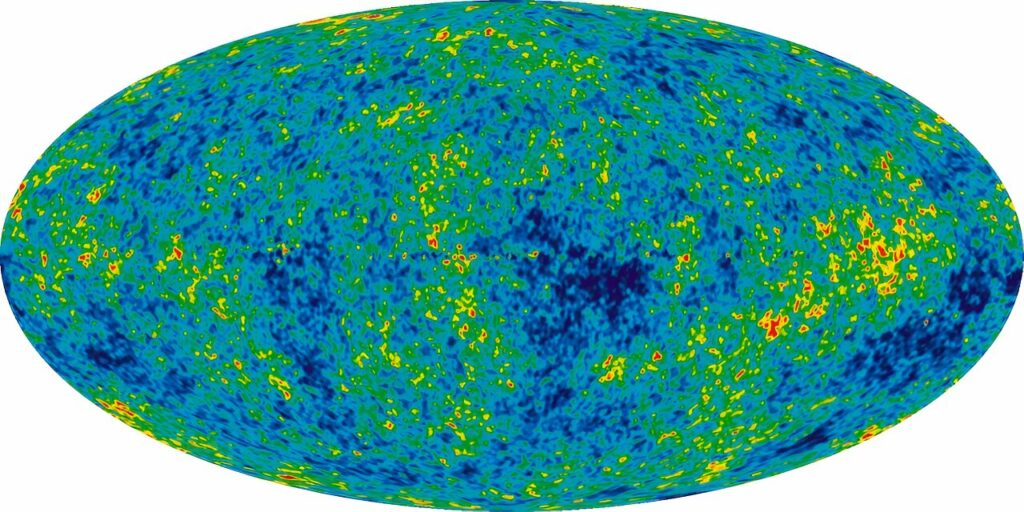Could the Existence of a Vast Void Explain the Mystery of the Universe’s Expansion? New Research Proposes a Solution
One of cosmology’s profound enigmas revolves around the rate of the universe’s expansion, a phenomenon predicted by the standard model of cosmology, known as Lambda-cold dark matter (ΛCDM). This model relies on meticulous observations of the cosmic microwave background (CMB), the residual light from the Big Bang.
As the universe expands, galaxies drift apart, their velocities dictated by Hubble’s constant, approximately 43 miles (70 km) per second per megaparsec. This implies that for every million light years a galaxy is distant from us, it gains about 50,000 miles per hour in speed.
However, a recent challenge to the standard model has emerged, introducing what scientists term the “Hubble tension.” Measurements of the expansion rate, when derived from nearby galaxies and supernovas, exceed predictions based on the CMB by 10%.
In a recent publication in the Monthly Notices of the Royal Astronomical Society, we propose a potential explanation: the concept that our cosmic address resides within a vast void, an expanse characterized by below-average density. We suggest that local measurements may be inflated due to matter outflows originating from the void. These outflows manifest when denser regions surrounding a void exert a greater gravitational pull, effectively pulling it apart.
In this scenario, our proximity to the center of a void with a radius of approximately a billion light years and a density roughly 20% below the universe’s average is crucial—though not entirely devoid of matter.
The existence of such an expansive and profound void challenges the expectations of the standard model, sparking controversy. While the CMB implies a relatively uniform distribution of matter in today’s universe, a direct count of galaxies in various regions hints at our location within a local void.
Tweaking the laws of gravity
We aimed to explore and validate this concept by aligning various cosmological observations under the assumption that our cosmic environment is a vast void expanding from a minute density fluctuation in its early stages.
In this pursuit, our model diverged from the conventional ΛCDM and embraced an alternative theory known as Modified Newtonian Dynamics (MOND). Originally conceived to elucidate irregularities in galaxy rotation speeds, which had led to the postulation of “dark matter,” MOND suggests an alternative explanation: Newton’s law of gravity falters in regions with extremely weak gravitational pulls, such as the outer reaches of galaxies.
While the overarching cosmic expansion history in MOND mirrors that of the standard model, structural formations like galaxy clusters would evolve more rapidly in MOND. Our model portrays the potential appearance of the local universe in a MOND framework, revealing the capacity for local measurements of the contemporary expansion rate to fluctuate based on our location.
Recent observations of galaxies have provided a pivotal examination of our model by assessing the predicted velocities at different locations. This involves measuring the bulk flow, the average velocity of matter within a given sphere, whether dense or not. Recent findings indicate that this phenomenon persists up to a billion light years. Intriguingly, the bulk flow on this scale exhibits a quadruple speed compared to the standard model’s expectations, and it appears to escalate with the size of the considered region—a trend contrary to the predictions of the standard model. The probability of this alignment with the standard model is exceptionally low, falling below one in a million.

This led us to investigate the implications of our study on the bulk flow. Our findings indicate a remarkably close alignment with the observed data. This alignment implies our proximity to the center of the void, with the void’s most vacant region situated precisely at its center.
Case closed?
Our findings emerge at a juncture where prevalent solutions to the Hubble tension encounter challenges. While some advocate for more precise measurements as a resolution, others posit that embracing the locally measured high expansion rate as the accurate one could solve the issue. However, this approach necessitates a subtle adjustment to the early universe’s expansion history to maintain the correct appearance of the cosmic microwave background (CMB).
Regrettably, a significant critique identifies seven issues with this alternative. If the universe were to expand 10% faster throughout the majority of cosmic history, it would consequently be about 10% younger, conflicting with the established ages of the oldest stars.
The identification of a profound and extensive local void in galaxy counts and the swift observed bulk flows strongly implies that structural growth surpasses expectations in ΛCDM on scales spanning tens to hundreds of millions of light years.
Compellingly, the early formation of the massive galaxy cluster El Gordo, with its excessive mass and collision speed, presents further evidence misaligned with the standard model, suggesting that structural formation occurs too slowly in this paradigm.
Given that gravity dominates on such expansive scales, it seems imperative to extend Einstein’s theory of gravity, general relativity—but solely for scales exceeding a million light years. Nevertheless, the challenge lies in the absence of effective methods to measure gravity’s behavior on much larger scales, where gravitationally bound objects of such magnitude are absent. While assuming the continued validity of General Relativity and comparing it with observations is a conventional approach, it is precisely this method that exacerbates the severe tensions confronting our preeminent cosmological model.
Einstein’s reputed statement that problems cannot be resolved with the same thinking that caused them suggests the need for a shift in our gravity theory. Even if the required adjustments are not radical, the current evidence may signify the first credible indication in over a century that a reevaluation of our theory of gravity is warranted.
Provided by The Conversation
Do not forget to share your opinion with us to provide you with the best posts !




0 Comments